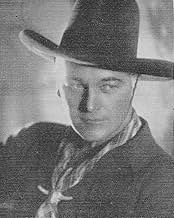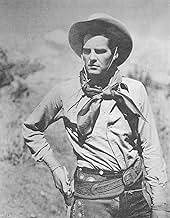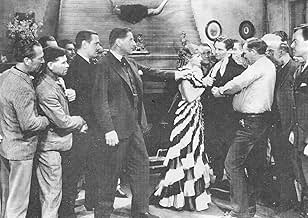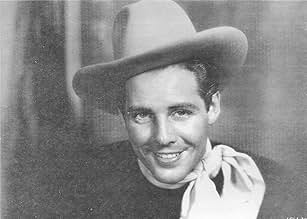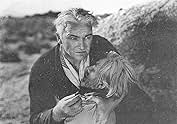Füge eine Handlung in deiner Sprache hinzuAn evil ranch foreman tries to provoke a range war by playing two cattlemen against each other while helping a gang to rustle the cattle.An evil ranch foreman tries to provoke a range war by playing two cattlemen against each other while helping a gang to rustle the cattle.An evil ranch foreman tries to provoke a range war by playing two cattlemen against each other while helping a gang to rustle the cattle.
- Regie
- Drehbuch
- Hauptbesetzung
James Ellison
- Johnny Nelson
- (as Jimmy Ellison)
George 'Gabby' Hayes
- Uncle Ben
- (as George Hayes)
Sid Jordan
- Wrangler
- (Nicht genannt)
John Merton
- Party Guest with a Pint in His Hip Pocket
- (Nicht genannt)
Pascale Perry
- Outlaw Guard
- (Nicht genannt)
Joe Phillips
- Party Guest
- (Nicht genannt)
Monte Rawlins
- Cowhand Party Guest
- (Nicht genannt)
Empfohlene Bewertungen
William Boyd made his screen debut as Hopalong Cassidy in Hop-ALong Cassidy. He was really William known as Bill Cassidy when he does arrive, but he gets wounded in a gunfight and limped a bit for the duration of the film. The guys in the bunkhouse called him Hopalong after he gave himself that nickname. Throughout the rest of the 66 films and TV shows we rarely heard his Christian name.
The plot is a standard western one, an outlaw gang stirs up a feud between the Bar 20 and a neighboring outfit owned by Robert Warwick. But it takes Bill Boyd to come up with the solution, aided and abetted by James Ellison whom he acquires as a sidekick.
Gabby Hayes is in this as Uncle Ben and he's the usual Gabby Hayes. He proved so popular that Paramount just resurrected him for the next few years before he left the series. Here as the chief villain guns him down it shows the Saturday matinée kids just how dastardly he is. Rather stupidly he leaves him to bleed out rather than finish him off. I guess Paramount did not want to shock the kids whose dimes to see the film and the subsequent series planned.
So Hopalong Cassidy becomes an American institution. Curiously enough Bill Boyd did a few non-Hoppy films after this before settling down into this character permanently.
It was a good beginning for an American institution.
The plot is a standard western one, an outlaw gang stirs up a feud between the Bar 20 and a neighboring outfit owned by Robert Warwick. But it takes Bill Boyd to come up with the solution, aided and abetted by James Ellison whom he acquires as a sidekick.
Gabby Hayes is in this as Uncle Ben and he's the usual Gabby Hayes. He proved so popular that Paramount just resurrected him for the next few years before he left the series. Here as the chief villain guns him down it shows the Saturday matinée kids just how dastardly he is. Rather stupidly he leaves him to bleed out rather than finish him off. I guess Paramount did not want to shock the kids whose dimes to see the film and the subsequent series planned.
So Hopalong Cassidy becomes an American institution. Curiously enough Bill Boyd did a few non-Hoppy films after this before settling down into this character permanently.
It was a good beginning for an American institution.
I thought the movie had the "feel" of western life..the cattle grazing in the opener..the dust on the outfits (except Johnny's!)You could even see the dust flying in several scenes....good characters, except the foreman (just didn't fit)..Ellison excellent as Johnny..and Hayes, McGlynn as Red and Middleton as Buck--all good...how about the scene where Hoppy appears riding Topper (I guess it was Topper,then) down that steep hill? I like the silent film "leftovers", like Hoppy's steely glare and the gathering of the ranchers scene near the end...Just a very well-done, enjoyable film! This movie borrows plot elements from the book Hopalong Cassidy (1910)-- Meeker, the H2 spread, Thunder Mesa..to name a few. I'm still reading the book, so I don't know all the details..! Interesting note-- the two well-known western character actors--Boyd and Hayes-- are from Eastern locales: Marion, Ohio and Wellsville, NY, respectively. Once again--a top rating for this film! John Field
Although the Character of Hopalong Cassidy had Virtually Nothing in Common with the Author Clarence Mulford's Novels...
William Boyd and "Hoppy" Maintained one of the Most Popular and Long Running Character Features in Movie History...(66 Films & TV).
"Hoppy" in the Movies Did Not...Smoke, Drink, or Result to Violence Unless Provoked and the "Bad Guy" Drew or Punched First.
A Complete Opposite of Mulford's "Hoppy", A Grizzled, Tobacco Chewing, Ruffian.
Unrealistic to a Fault, but Not as Unrealistic as say Gene Autry, Roy Rogers or Other Kid's Heroes of the Day.
It's Not Easily Understood Why the Character was So Popular.
His Outfit was Black from Head to Toe, and sure was the Antithesis of Gene and Roy where Only the Bad-Guys Wore Black.
It was a Stunning Contrast to His Horse "Topper" an All-White Stallion.
Add to That Boyd's Hair was Completely Premature White.
These Things Certainly Helped the "Hoppy" Image.
Although Extremely Popular in His Initial Reincarnation with a Steely-Stare and an Edge,
"Hoppy's" Entrance is a Thrilling Descent Down a Steep Decline Aboard "Topper".
Boyd's "Hoppy" Became More and More Docile as the Character and the Film-Series Aged.
This First Entry, was Re-Titled "Hopalong Cassidy Enters" in Re-Release to Point Fans to the Origin,
is a Visual-Treat with Wide-Open Spaces and Horses Always Moving, Bucking, and Galloping.
The Plot Has Mystery Elements and George "Gabby" Hayes as "Uncle Ben"
Makes for a Sentimental and Emotional Touch with One-Scene Unforgettable.
For B-Western Fans...A Must See.
William Boyd and "Hoppy" Maintained one of the Most Popular and Long Running Character Features in Movie History...(66 Films & TV).
"Hoppy" in the Movies Did Not...Smoke, Drink, or Result to Violence Unless Provoked and the "Bad Guy" Drew or Punched First.
A Complete Opposite of Mulford's "Hoppy", A Grizzled, Tobacco Chewing, Ruffian.
Unrealistic to a Fault, but Not as Unrealistic as say Gene Autry, Roy Rogers or Other Kid's Heroes of the Day.
It's Not Easily Understood Why the Character was So Popular.
His Outfit was Black from Head to Toe, and sure was the Antithesis of Gene and Roy where Only the Bad-Guys Wore Black.
It was a Stunning Contrast to His Horse "Topper" an All-White Stallion.
Add to That Boyd's Hair was Completely Premature White.
These Things Certainly Helped the "Hoppy" Image.
Although Extremely Popular in His Initial Reincarnation with a Steely-Stare and an Edge,
"Hoppy's" Entrance is a Thrilling Descent Down a Steep Decline Aboard "Topper".
Boyd's "Hoppy" Became More and More Docile as the Character and the Film-Series Aged.
This First Entry, was Re-Titled "Hopalong Cassidy Enters" in Re-Release to Point Fans to the Origin,
is a Visual-Treat with Wide-Open Spaces and Horses Always Moving, Bucking, and Galloping.
The Plot Has Mystery Elements and George "Gabby" Hayes as "Uncle Ben"
Makes for a Sentimental and Emotional Touch with One-Scene Unforgettable.
For B-Western Fans...A Must See.
A range war is brewing between the Bar 20 and Meeker ranches, which is being caused by Meeker's foreman Anthony (who is in reality, an outlaw called the Pecos Kid), whose method is to have each ranch be accused at acts of rustling cattle or murder, then the two ranches will start a war against each other. In the meanwhile, Anthony's gang will round up all the cattle from the two ranches, change brands, and sell them at market. It's up to Hoppy, Red, Uncle Ben, and Johnny Nelson (who is a target for Meeker's hands since Johnny is sweet on Meeker's daughter Mary) to clear the Bar 20's name and round up the outlaws. The film is a very good entry in the opening film of the Hopalong series, but far from the best, since the action doesn't really begin past the halfway point of the film. Then on it's gets better building up to a great climax. Good performances by the cast (especially by Hayes as Uncle Ben, in a pre Windy Halliday role), but Thomson is miscast and ineffective as Anthony. Rating, based on B westerns, 6.
"Hop-Along Cassidy" (aka "Hopalong Cassidy Enters") was the first of 66 features starring William Boyd as Hoppy. One of the most successful and best written of the "B" western series, it was to run from 1935 to 1948.
As written by Clarence E. Mulford, Cassidy was a crude, crusty ranch hand and definitely not intended as a Saturday Matinee hero. In fact, character actor James Gleason, who looked nothing like a hero was apparently first offered the part.
Boyd, who had been around Hollywood since the early 20s and had fallen from grace, ultimately was cast in the part. It was decided between himself and producer Harry "Pop" Sherman that Boyd would not play the character as written.
In this first entry in the series, Boyd plays the character with a few rough edges, all of which would disappear in future films. He starts out as "Bill" Cassidy but acquires his nickname "Hopalong" when is wounded in the leg and is forced to hop along with the aid of a cane.
The story involves two competing ranchers, Buck Peters of the Bar-20 (Charles Middleton) and Meeker (Robert Warwick) arguing over the open range land for their cattle. Meeker's foreman known as Pecos Jack (Kenneth Thompson) is behind a plot to set the two ranches against each other while stealing their cattle, changing their brands and selling them off for himself.
In this first entry in the series the traditional trio comprises Hoppy, Johnny Nelson (James Ellison) and Red Connors (Frank McGlynn Jr.). George Hayes by this time had evolved into the character he would play for the rest of his career. In this picture he plays a ranch hand named "Uncle Ben". Although still not using the name "Gabby", he would appear later in the series as the grizzled sidekick "Windy Halliday".
Also in the cast are Paula Stone as Mary Meeker, Ellison's love interest, Willie Fung as the Meeker's Chinese cook, who provides most of the comic relief, and veterans John Merton and Franlyn Farnum in other roles.
Charles Middleton would achieve some measure of fame as "Ming the Merciless" in the Flash Gordon serials. The character of Red Connors would be resurrected in the Hopalong Cassidy TV series of the 50s with Edgar Buchanan playing the part.
As written by Clarence E. Mulford, Cassidy was a crude, crusty ranch hand and definitely not intended as a Saturday Matinee hero. In fact, character actor James Gleason, who looked nothing like a hero was apparently first offered the part.
Boyd, who had been around Hollywood since the early 20s and had fallen from grace, ultimately was cast in the part. It was decided between himself and producer Harry "Pop" Sherman that Boyd would not play the character as written.
In this first entry in the series, Boyd plays the character with a few rough edges, all of which would disappear in future films. He starts out as "Bill" Cassidy but acquires his nickname "Hopalong" when is wounded in the leg and is forced to hop along with the aid of a cane.
The story involves two competing ranchers, Buck Peters of the Bar-20 (Charles Middleton) and Meeker (Robert Warwick) arguing over the open range land for their cattle. Meeker's foreman known as Pecos Jack (Kenneth Thompson) is behind a plot to set the two ranches against each other while stealing their cattle, changing their brands and selling them off for himself.
In this first entry in the series the traditional trio comprises Hoppy, Johnny Nelson (James Ellison) and Red Connors (Frank McGlynn Jr.). George Hayes by this time had evolved into the character he would play for the rest of his career. In this picture he plays a ranch hand named "Uncle Ben". Although still not using the name "Gabby", he would appear later in the series as the grizzled sidekick "Windy Halliday".
Also in the cast are Paula Stone as Mary Meeker, Ellison's love interest, Willie Fung as the Meeker's Chinese cook, who provides most of the comic relief, and veterans John Merton and Franlyn Farnum in other roles.
Charles Middleton would achieve some measure of fame as "Ming the Merciless" in the Flash Gordon serials. The character of Red Connors would be resurrected in the Hopalong Cassidy TV series of the 50s with Edgar Buchanan playing the part.
Wusstest du schon
- WissenswertesWilliam Boyd was originally offered the role of Buck Peters, the Bar 20 ranch foreman, but chose the role of Cassidy.
- VerbindungenEdited into Border Justice (1951)
- SoundtracksFollowin' the Stars
Music and lyrics by Sam H. Stept and Dave Franklin
Sung by James Ellison and Frank McGlynn Jr.
Played as background music often
Top-Auswahl
Melde dich zum Bewerten an und greife auf die Watchlist für personalisierte Empfehlungen zu.
Details
Box Office
- Budget
- 85.000 $ (geschätzt)
- Laufzeit
- 1 Std.(60 min)
- Farbe
- Seitenverhältnis
- 1.37 : 1
Zu dieser Seite beitragen
Bearbeitung vorschlagen oder fehlenden Inhalt hinzufügen


